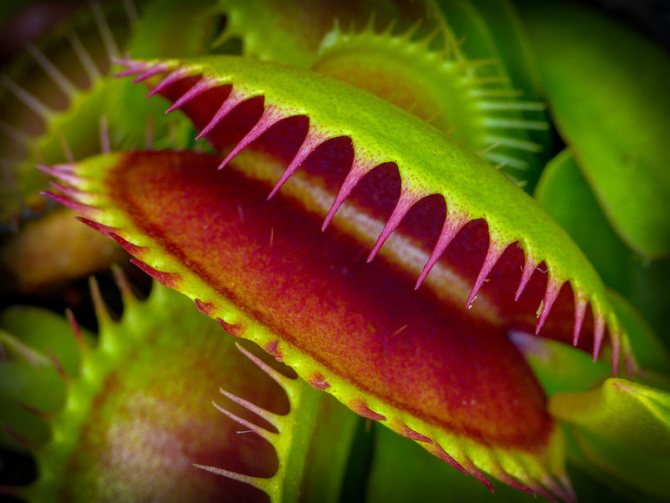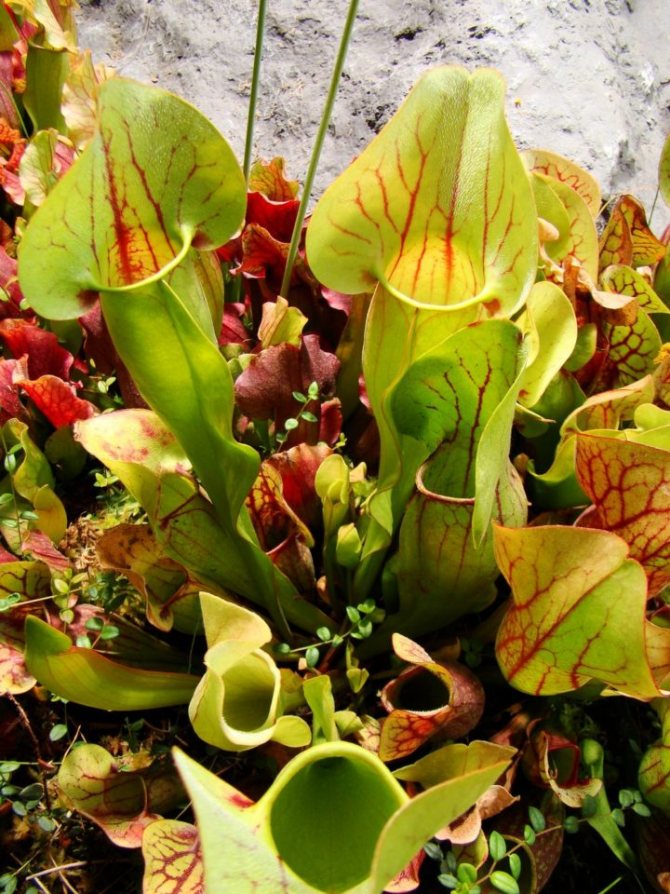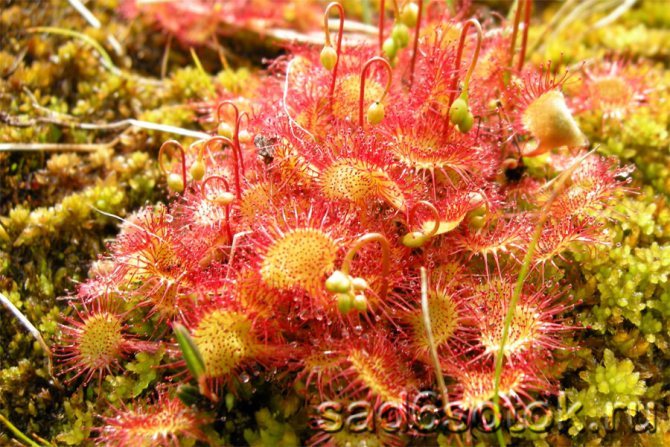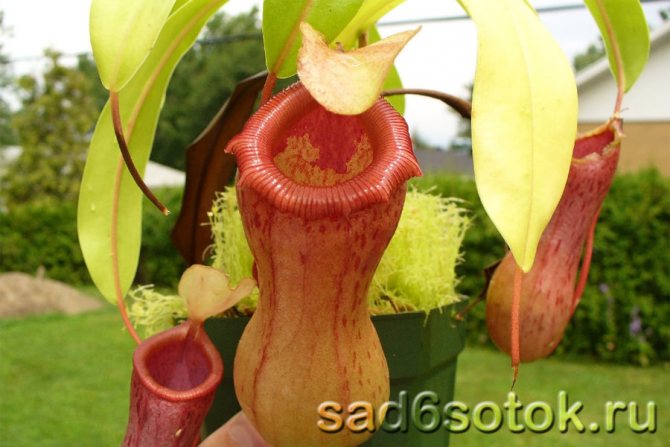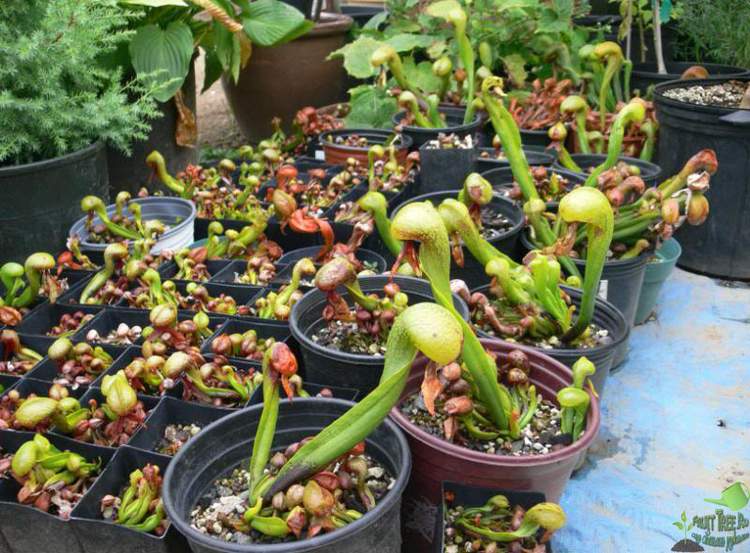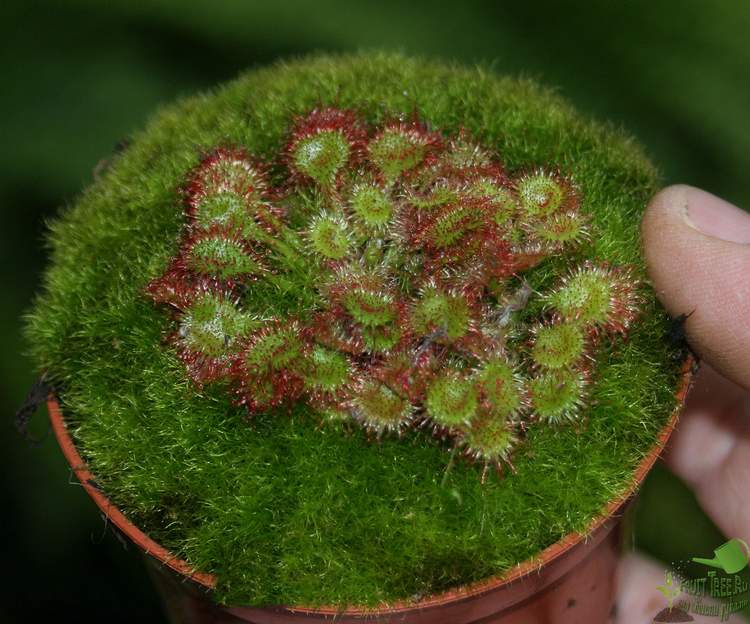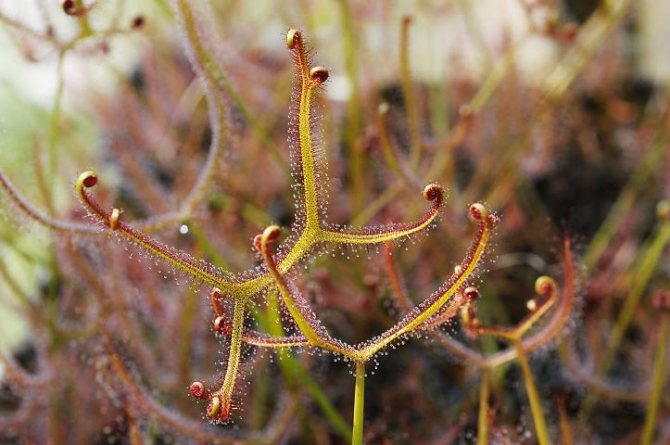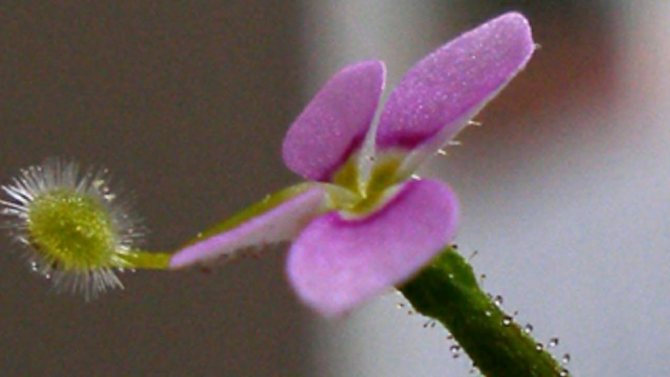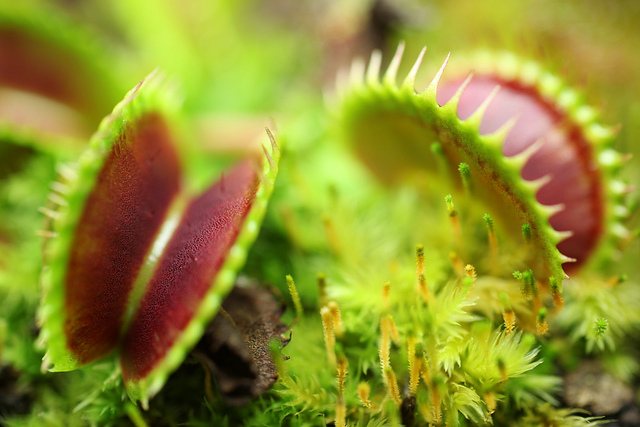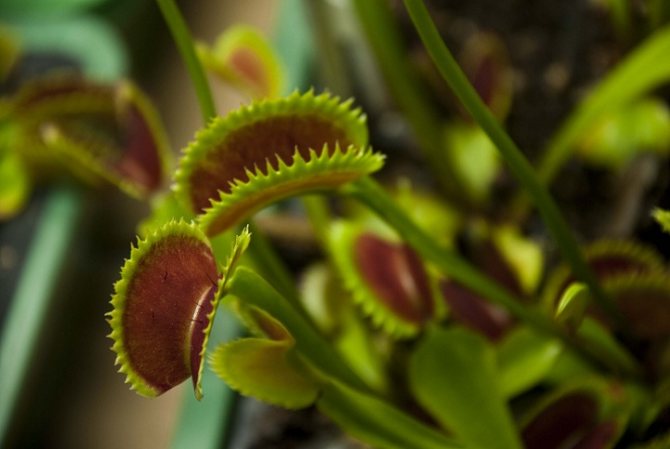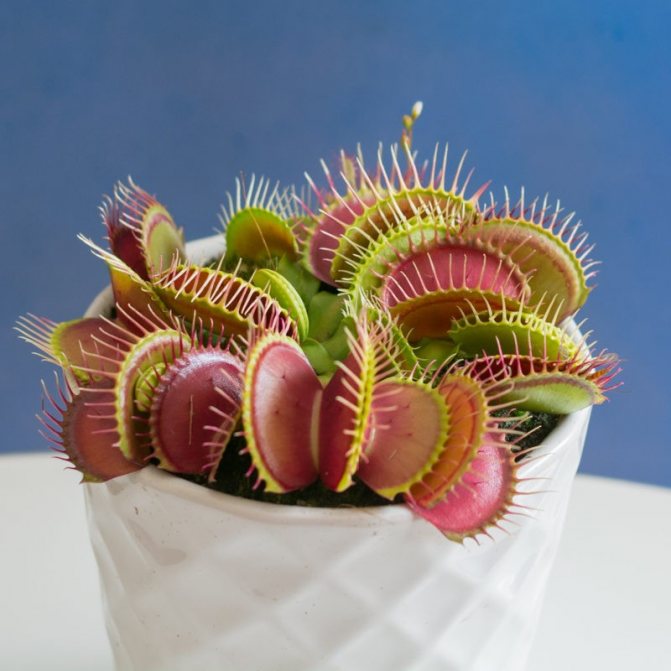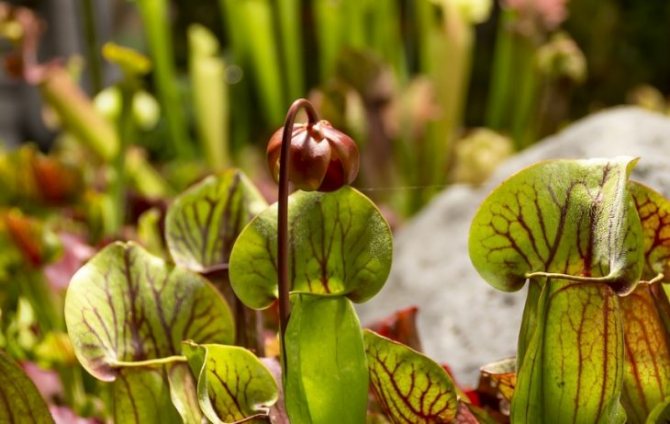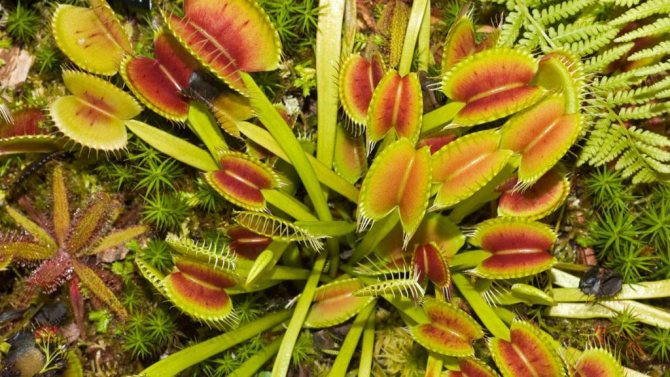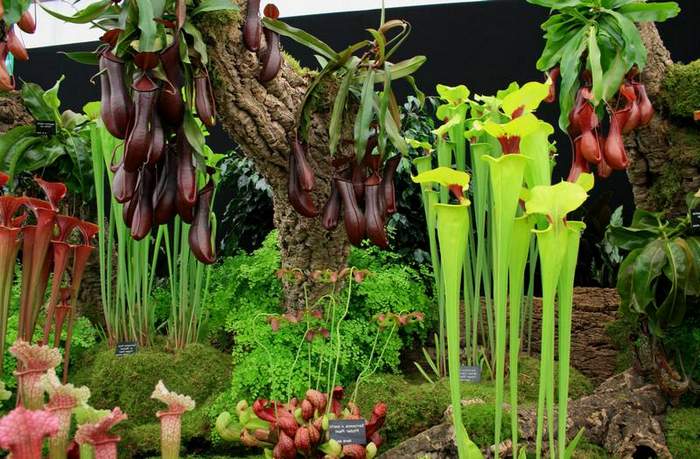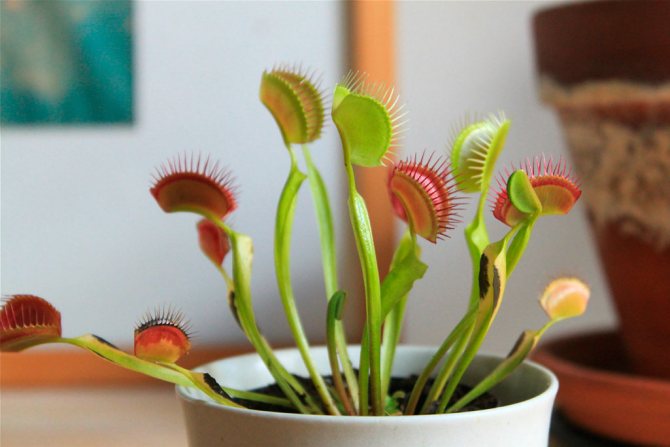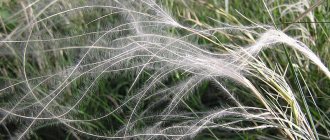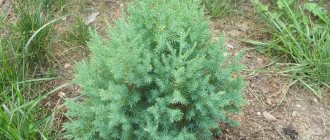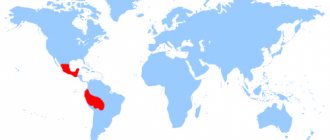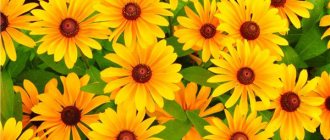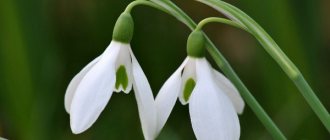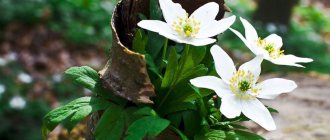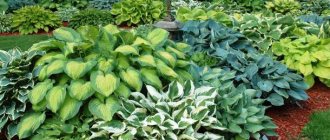Insectivorous plants - popular species, care
Plants that are able to catch and eat insects and small animals are of great interest and surprise. And lovers of indoor flowers are sure to try to purchase these flowers in their collections.
In nature, predatory plants are found on almost all continents. They belong to 19 different families. Currently, about 630 species of these amazing creatures are described. Most of them come from tropical areas, but there are species that feel quite comfortable in cooler regions.
So, even in the bogs near Moscow, you can find round-leaved sundew (Drosera rotundifolia)
, but
American sarracenia purpurea (Sarracenia purpurea)
has long settled in England and Ireland.

Sarracenia purpurea
The first descriptions of plants capable of self-feeding by hunting appeared in the 18th century. They were compiled by the English naturalist John Ellis. The discovery was so unexpected that even many scientists of that time took the information with distrust.
Nepentes
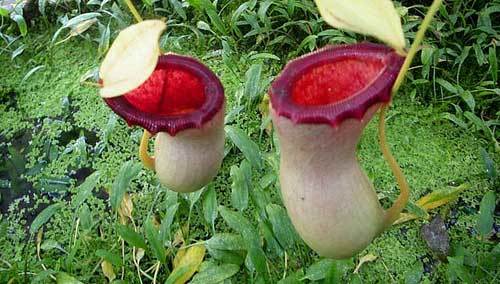

The main difference between tropical jugs of the genus Nepenthes from other carnivorous plants is their size: the "jug" of this plant can reach a length of more than 30 cm, it is ideal for capturing and digesting not only insects, but also small lizards, amphibians and even mammals. (Doomed animals are attracted by the sweet smell of the plant, and once they are in the jar, the nepentes begins to digest them, a process that can take up to two months!) There are about 150 species of Nepenthes scattered around the eastern hemisphere; jugs of some plants are used by monkeys as drinking cups (after all, these animals are too large to be in the wrong place in the food chain).
What carnivorous plants are grown at home
Some carnivorous plants are already common at home. Sundew, Venus flytrap, and Nepentes have long been familiar to fans of indoor greenhouses. Other predatory plants are just settling into city apartments.
The list of carnivores includes representatives of the aquatic life. Feeding on small inhabitants of ponds and lakes, they also obtain the necessary food by hunting. Such predatory plants are of interest to aquarists or those who maintain open water bodies.
Venus flytrap
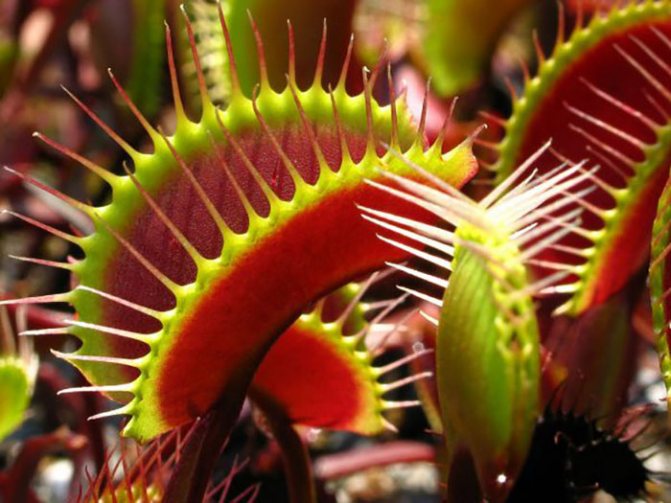

A resident of the marsh outskirts in indoor conditions for proper development needs conditions that a caring florist is quite capable of providing:
- bright saturated light - south window or supplementary lighting;
- planting in a light pot, since the soil and roots overheat in the sun, and this marsh plant does not tolerate;
- constant moisture level: do not fill and dry the soil;
- feeding only through traps - no root feeding;
- correct wintering.
More about the last point. In the fall, the predator plant sheds withered blackened foliage. Inexperienced growers believe that they have not coped with the care and throw the flower away. And the Venus flytrap was just going to rest - to sleep. In this state, she will safely overwinter until February-March in the cellar. It is more convenient to store a sleeping predator at home in the coldest place - at the balcony door or in the refrigerator.
The flycatcher is fed every 2 months.If there are no insects in the room, then a live victim is put in the open "mouth" -trap - a fly, a mosquito, a caterpillar, a butterfly. If the food is inanimate, then it is not enough just to put it in the feeder. Slightly moving it along the inner surface of the jaws of the predator plant, they achieve the touch of sensitive hairs so that the flycatcher reacts and slams shut.
And teasing - sticking something inedible into a trap or just moving something to see how it works - is impossible for two reasons:
- The number of open-close cycles is limited. The pampering of the curious leads to the fact that the reserve of working capacity is exhausted, and the plant remains hungry.
- Idle collapse of traps slows down the release of substances with the help of which the flycatcher assimilates nutrients from living organisms.
Important! The flower does not eat meat and meat products (sausage, sausages). Hard beetles and earthworms are not offered to a flower either. Having decided to start a Venus flytrap, the florist should initially think about the proper nutrition of the plant.
Zhiryanka
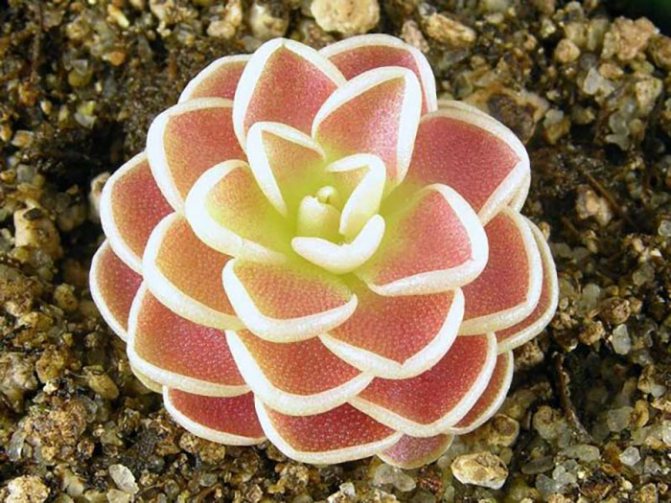

This charming plant with blue flowers, somewhat reminiscent of a violet, will easily feed itself on small midges. Delicate leaves, collected in a neat rosette, are covered with an oily sweet syrup that looks like droplets of fat, explains the name.
Moshkaru is attracted by the smell of sweet glue. Florists compare the dexterity of fat women with hanging sticky tapes against flies. The leaf plates of the predator plant are able to digest prey without twisting, but if the prey actively resists, then the plant fixes the insect, slowly folding.
Pemphigus
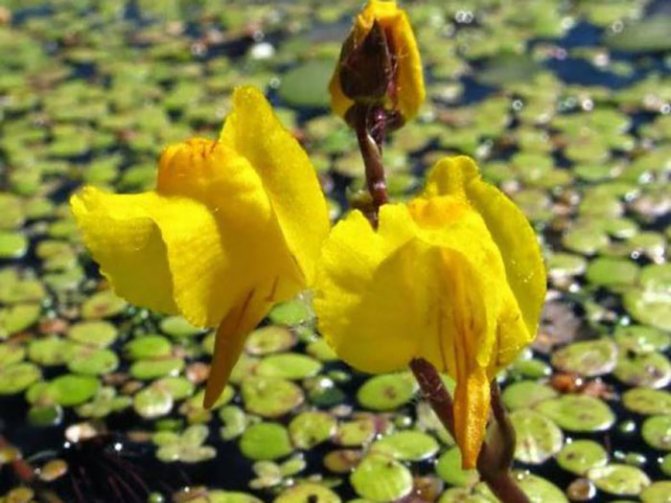

Aquarists are familiar with this predatory plant, as the carnivorous pemphigus is a resident of water bodies. The stem is covered with narrow leaves and trap bubbles up to 5 mm in diameter, always in water. And yellow flowers rise above the surface, giving the reservoir a special decorative effect.
The predator plant hunts for the smallest organisms inhabiting shallow water, fry of fish, frogs, insects. They enter the vesicle through a valve that opens when the sensitive antennae-hairs are irritated. The victim cannot get out back. The plant gets the nitrogen it needs by digesting small insects.
A predatory plant does not pose a threat to aquarium inhabitants at home. Since the water quality and abundance of food in a well-kept aquarium is sufficient, pemphigus does not need to strain to hunt. She will receive everything she needs from the water through the leaves, and the bubbles, as unnecessary, disappear over time.
Nepentes
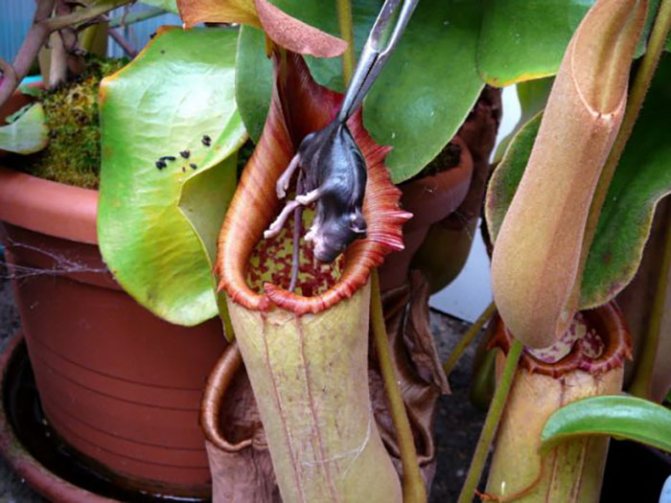

A plant with an original leaf shape in nature is able to extract nitrogen not only from living organisms, but from the feces of small animals - tupaya or bats, which settle in a cozy jug for the night.
At home, it is enough for this predatory plant to put insects - spiders, butterflies, flies in several trapping containers once a month. If the house has an aquarium, then live food - bloodworms - will also work. In the summer, when food itself crawls under the lid of the jug, the florist is also freed from this obligation. It remains only to provide an abundance of ambient light and high humidity.
Features of nepentes:
- Doesn't like the slightest movement. It is better not to move the pot with the plant, not to disturb the flower. Otherwise, the predatory plant will slow down development, freezing up to one and a half months.
- Since this is a liana, a support is equipped for good growth when the nepentes reaches one year of age and a transplant is required.
- At the bottom of each pitcher-stomach, digestive juice is produced once, which is not renewed. The insect is completely absorbed in this liquid within 24 hours. But it happens that the digestive secret disappears - it dries up. Then, up to a third of the volume of distilled water is poured into a jug so that the leaf does not die.
The plant does not have a pronounced wintering, but the conditions of care are changing. It is watered less and less often, and it is not necessary to feed it until spring at all. Since February, the irrigation regime is restored, the dried parts of the plant are cut off, and from March they begin to feed.
Sarracenia
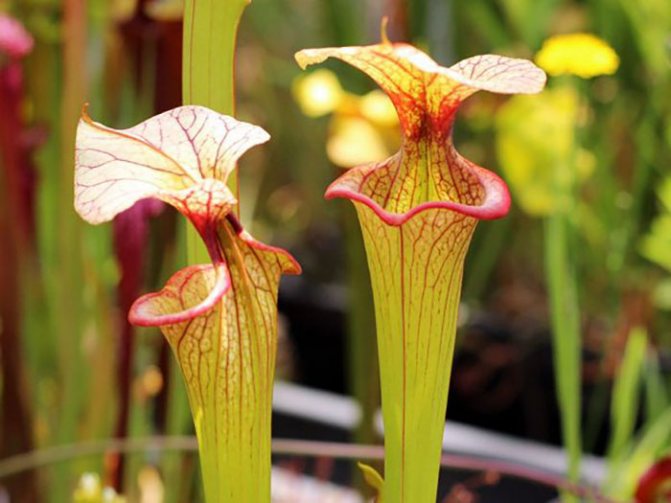

Spectacular plant with tubular leaves growing from the rhizome. The principle of operation is the same as that of nepentes: a container filled with a liquid with an attractive odor is the place of digestion of prey. The leaves of the predatory plant are white, yellow, green with a dense network of bright veins.
The victim falls into the trap due to the frequent strong villi directed from top to bottom. Insects attracted by the smell slide into the cavity, from where there is no way out: the prey drowns in the digestive secretion.
Care features:
- the constant standing of water is allowed in the pallet: if the conditions (light, heat) are met, then up to half the volume of the pot; with a lack of lighting and temperature - no more than a third;
- for the winter, the entire aboveground part is cut off, the rhizome is kept in slightly damp soil, temperature is + 5 + 10;
- direct sunlight for at least 6 hours.
If the daily care of a predatory plant is not difficult, then the annual cycle must be ensured, otherwise the sarcenia will lose its decorative effect or die.
Sundew


The shapes and sizes of the representatives of the family are very diverse. Leaves in the form of small saucers, long tongues, resembling spoons. Stems of some species in nature reach 2-3 meters. Such a sundew eats even rather large insects.
At home, this charming carnivorous plant is quite compact. More often there are specimens with rounded or lanceolate leaves, from which long reddish or white-yellow filaments-cilia stretch in all directions. At the end of each is a shiny drop of sticky mucus. Having touched such an adhesive base, the insect sticks, and trying to free itself from the trap, it touches more and more stickies and finally gets bogged down.
Sundew, meanwhile, begins to activate. Sensing prey, neighboring cilia reach out to the victim - rounded leaves curl up into a "fist", and long ones - into a roll. The insect has no chances to escape.
Glutinous dew contains:
- alkaloids to immobilize the victim;
- enzymes that dissolve chitinous integuments;
- enzymes, with the help of which the predatory plant begins to digest prey, assimilate nutrients.
Such a predatory plant lives in a pot for decades, without requiring special care and soil replacement. A florist will add water to her, and the flower will get all the elements necessary for growth and development on its own.
Aldrovanda


The Red Data Book carnivore plant is another algae on the list of carnivorous inhabitants of water bodies. As a relative of the sundew, it gets its own food in a similar way. Leaves with sensitive villi secrete a sticky mucous secret that attracts aquatic life. At the slightest sign of a successful hunt, the trap is slammed shut. Interestingly, it is disposable in the Aldrovanda: it caught the victim, digested it, and died. A new trap is formed in the vacant place.
Darlingtonia
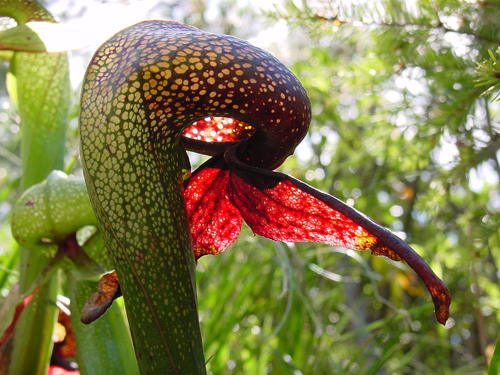

Darlingtonia is a rare carnivorous plant that grows in the cold waters of the swamps of Oregon and northern California. This is truly a devilish plant: it not only lures insects into its jug thanks to its sweet aroma, but it has numerous false "exits" in it, because of which its doomed victims make unsuccessful attempts to get out.
Ironically, naturalists have yet to identify the natural pollinators of Darlingtonia; it is known that a certain type of insect collects the pollen of this flower and remains unharmed, but it is not yet known which one.
The prevalence of entomophagous plants
Predatory plants are not only exotic representatives of the biosphere. They are found everywhere - from the equator to the Arctic.Most often, they can be stumbled upon in wet places, especially in swamps. Most species are recorded in the southwestern part of Australia. Some species are eurybionts and grow in many biocenoses. The range of other species is more limited - for example, the Venus flytrap in nature is found exclusively in South and North Carolina.
In Russia, there are 13 species of carnivorous plants from 4 genera. The genus Rosyanka is represented by two species: common sundew and English sundew. They grow mainly on sphagnum bogs. Aldrovand vesiculosus occurs both in the European part of the Russian Federation and in the Far East and the Caucasus.
The genus Pemphigus in Russia is represented by four species, the most common of which is pemphigus vulgaris. These are aquatic plants that differ in their growth rate. They are found in shallow waters throughout Russia (with the exception of the Far North). Also in our area you can find representatives of the genus Zhiryanka, which grow on swamps, stream banks, and some - on trees and mosses.
Stylidium


It is still unclear whether the plants of the genus Stylidium are truly carnivorous, or are simply trying to protect themselves from annoying insects. Some species are equipped with sticky hairs that capture small insects that have nothing to do with the pollination process, and their leaves secrete digestive enzymes that can slowly dissolve unfortunate victims. Further research is needed to elucidate the significance of consumed insects for the life of the stylium.
Round-leaved sundew
The round-leaved sundew is a representative of insectivorous plants in Europe and the CIS countries. Most often it can be found in the middle climatic zone of Russia, growing in swampy areas, in places deprived of useful minerals - "acidic soils".
In the summertime, a blooming sundew can be recognized by its small white flowers growing on a long peduncle stem. The sundew itself, a rather inconspicuous marsh insectivorous grass with leaves on the ground, strewn with hairs. The fluid secreted by the hairs is very similar to dew, but in reality it is a deadly glue for insects, as well as an enzyme for digesting prey.
The victim, attracted by the smell of "dew", sits down on a leaf and sticks to it. The hairs press the unfortunate creature to the surface of the leaf, and the enzyme begins the process of dissolving food, and the leaf itself, meanwhile, curls up, depriving the prisoner of all chances of salvation. The remains, which the sundew did not digest, fall to the ground, the leaves take their usual form, the hairs are covered with "dew" beads and a new hunt begins.
Trap leaves, covered with red tentacle hairs (from 20 to 30 pieces per leaf), play their role no more than five times. They then dry out and fall off, replaced by freshly grown ones.
Some, especially large, sundew species can catch even unwary frogs or small birds. Science knows about 130 varieties of this plant. And in the days of Ancient Russia, the Slavic peoples used sundew to prepare decoctions for colds.
Rosolist


Rosolist grows in nutrient-poor soils along the coasts of Spain, Portugal and Morocco, so it supplements its diet with rare insects. Like many other carnivorous plants on this list, dewdrop attracts insects due to its sweet scent; its leaves contain a sticky mucous substance that does not allow the victim to move, and then with the help of digestive enzymes, the unfortunate insects slowly dissolve and the plant receives the necessary nutrients.
General description of carnivorous plants
Most of the exotic, which feed themselves, live in the tropics, more often in open wetlands.Abundance of moisture, sun, high temperature are the main characteristics of the natural habitat.
The bait is the aroma of nectar or special secretions on the surface of the leaves, the tips of the cilia. Through these thin sensitive antennas, the predator plant receives a signal of prey and further behavior - the most exciting part of the spectacle. Some, like sundews, gently fold the trapping surface, capturing the victim completely. Other carnivorous plants instantly snap the trap.
Domestic predator plants behave in the same way, but often, especially in winter, when there are not so many insects, the growers themselves provide the food base.
Roridula
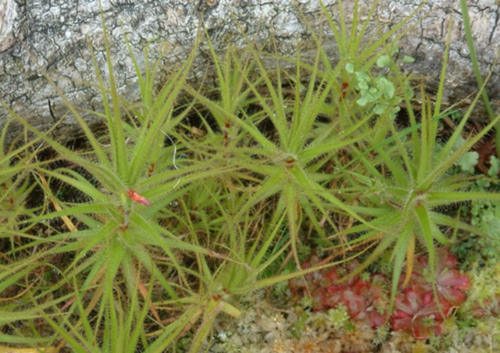

Native to South Africa, roridula is a carnivorous plant, although it actually cannot digest insects captured with sticky hairs. The plant leaves this task to the horseflies of the species Pameridea roridulae, with which it has a symbiotic relationship. What does roridula get in return? Waste bugs are an excellent fertilizer.
By the way, in the Baltic region of Europe, fossils of roridula, 40 million years old, were found, which is evidence of a wider distribution of this species during the Cenozoic era, relative to the current range.
Where green predators are common
The distribution area of insectivores is quite wide, they can be found in different ecosystems in which flowers can grow, from the tropics to the Arctic zone, in wetlands and desert areas, in the alpine mountain belt. Most often found in countries with warm, tropical climates.
On the territory of Russia there are:
- sundew of two types;
- water bladder Aldrovand;
- representatives of fat women;
- several varieties of pemphigus.
Zhiryanka
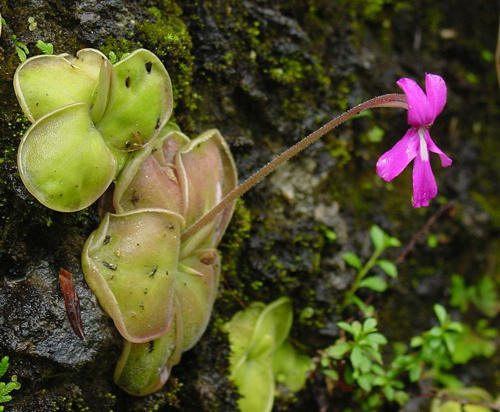

The plant got its name from its wide leaves with an oily coating. This carnivorous plant is native to Eurasia and North, South, and Central America. The fatty woman's victims are immersed in sticky mucus and are slowly dissolved by digestive enzymes. If the insects try to move, the leaves begin to curl slowly, while the sticky mucus dissolves the proteins of the prey.
Trap mechanisms and types
Plants-predators, depending on the hunting organs, are divided into groups:
- with moving trapping organs such as the flycatcher and sundew;
- passive-catching, using sticky secretions on the leaves, such as jug-like trapping organs, nepentes, pemphigus
According to the classification of biologists, traps can be:
- sticky;
- sucking;
- jug-shaped leaves;
- closed by leaves with a trap structure;
- traps similar to the claws of a crab.
The relationship between trap type and predator family is not tracked.
Genlisei
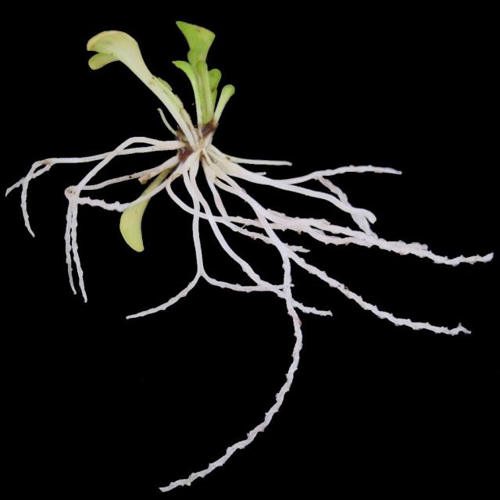

Unlike other carnivorous plants on this list, the genlisea's diet is likely to consist of protozoa and other microscopic organisms, which it attracts and eats using specialized leaves growing underground. These underground leaves are long, light-colored and similar in appearance to roots, but the plant also has the usual green leaves that are above the ground and participate in the process of photosynthesis. Genlisea is common in the regions of Africa, Central and South America.
Pemphigus
Pemphigus is a predatory plant whose habitat is stagnant water. Pemphigus is deprived of the roots of nutrition habitual for plants, which is why it preys on insects and small crustaceans. Fishing "bubbles" are under water together with leaves, and only its flowers float on the surface.
The “bubbles” have a kind of “entrance” that opens as soon as an insect is near. The signal about the opening of the "bubble" comes from the hairs-probes located near the "entrance". When the insect catches the hair, the "bubble" opens and it is drawn in along with the water.And at the next stage of the hunt, the digestion of food begins.
Venus flytrap
The Venus flytrap is another carnivorous plant: maybe not the largest, but certainly the most famous in the Droseraceae family. It is rather small (no more than 15 cm in length) and its sticky "trap" is the size of a matchbox.
Interesting! The Venus flytrap has developed a unique trap mechanism to reduce false flapping due to falling leaves and debris: it only slams when two different inner hairs touch for 20 seconds.
Green jaws
But the flapping green "jaws" look especially impressive Venus flytrap (Dionaea muscipula)
... Her traps are equipped with sensitive hairs located on the inside. If you touch them, a special "closing" mechanism is triggered. Moreover, the Venus flytrap is able to distinguish between its prey. If something inedible (for example, a blade of grass) hits her, the trap opens again and waits for its happy hour.
This trinity: sundew (Drosera),
nepentes (Nepenthes) and Venus flytrap (Dionaea muscipula) -
now it is easy to find on sale. It is not so easy to grow them, they will not live long in unsuitable conditions, so before buying it is worth thoroughly preparing and assessing your capabilities.
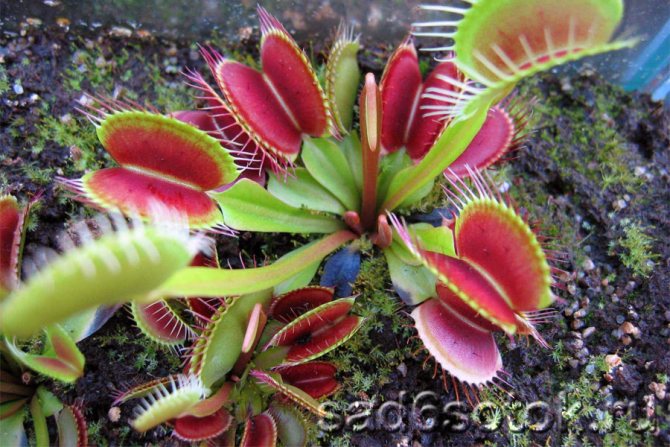

Venus flytrap (Dionaea muscipula)
Cephalot
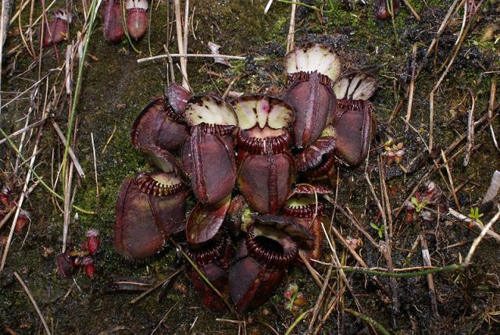

The cephalott attracts insects with its sweet aroma, and then lures them into a jug, where the unfortunate prey is slowly digested. To further confuse the prey, the lids of these jugs look like translucent cells that give the victim hope to get out of them.
Unusually, the cephaloth is related to flowering plants (such as apple and oak), which is not the case with other carnivorous plants.
Sarracenia
In the Sarracenia family, all species (and there are nine of them) live in swamps.
Sarracenia has bright flowers and bright green leaves dotted with crimson capillary lines. The leaves resemble envelopes exuding sweet juice. Falling into such a trap, the insect is doomed. But the scenario with digestion and assimilation is still the same.
European gardeners are actively introducing sarcenia into their collections and are developing new species that harmoniously fit into home landscapes.
Cause of carnivorous plants
Almost everything that grows from the earth feeds on its juices. To do this, they have a root system, often very branched, through which nutrients enter the stem, and then are absorbed, turning into wood, fiber, leaves, and sometimes beautiful inflorescences pleasing to the eye. The better the soil, the more possibilities. This applies to all types of flora, from grasses to huge sequoias. Unfortunately, climatic diversity does not always contribute to the growth and survival of biological objects. The land is not fertile everywhere. So we have to adapt, not only to people, but also to all our other space satellites. Indeed, in essence, we are flying in space, surrounded by a dead vacuum, and our world has become alive because we have air, water, heat and many other things that are extremely necessary. Carnivorous plants feed on creatures that are on the evolutionary ladder above them, not because of innate cruelty, they are forced to get the substances necessary for their life because there is nowhere else to take them.
The use of Rosyanka for medical and economic purposes
The Rosyanka herb, collected during its flowering, is used for coughs, bronchitis, including whooping cough. It has been proven that it contains a substance such as plumbagon - an antibiotic that helps in the fight against microbes and pathogenic fungi - streptococci and staphylococci. It is used by homeopaths to prepare nutritional supplements. Outwardly, Rosyanka juice is used to eliminate warts and old corns.For this, young, freshly plucked leaves are used. The inner part of the leaf, where the glandular hairs are located, is rubbed with warts or calluses. After several procedures, they disappear. And decoctions of dried leaves of Rosyanka are used as diuretics and diaphoretic agents, for fevers, for eye diseases. We draw your attention to the fact that not fresh leaves are used for decoctions, but dry raw materials. It is best to harvest it in the summer, during the flowering period, although it is possible during the entire growing season, while the Rosyanka is above the soil surface. It is better to dry with dryers, at a temperature of 40 grams. But it is also possible in a well-ventilated area. Store - in cloth bags for no more than two years.
Infusions are recommended to drink for asthma, atherosclerosis, diarrhea, dropsy, dysentery, as well as for headaches. Prepare them like this: 1 tsp. dry grass Rosyanka is poured with 1 glass of boiling water. Insist for one hour, filter and squeeze the grass. The resulting solution is consumed after meals 3-4 times a day for 1 tbsp. spoon. It is important not to exceed the indicated doses in order not to cause vomiting or digestive upset.
Pharmacies sell ready-made alcoholic tinctures of Rosyanka for the treatment of upper respiratory tract diseases. Alcohol tincture can be prepared on your own in a ratio of 1:10. Take 10 g of dried herb Rosyanka and 100 ml of 40% alcohol or vodka. Insist in a dark place at room temperature for 10 days. They are filtering. Then it is used as a pharmaceutical preparation. Children are given 10 drops, diluted with water, 3-4 times a day. Adults - 15 drops in a glass of water 4 - 5 times a day.
But it is important to know that all parts of the plant are poisonous. Self-medication is dangerous. Any non-observance of the dosage threatens with poisoning. Therefore, before treating diseases with the help of any parts of the Rosyanka, consult a specialist.
In the North, Rosyanka is used for steaming milk storage pots. Over time, milk in pots is poorly stored, it begins to turn sour quickly. Then a sundew with a little water is placed in the jug. The jug is placed in a Russian oven and steamed for a while. The enzymes found in the leaves of Rosyanka dissolve all organic substances left after souring milk and penetrated deep into the clay pores of the pot. After steaming with Rosyanka, the milk in such a jug is again stored for a long time and does not turn sour.
In Italy Rosyanka is used in the preparation of Rosolio liqueur.
Habitat and habitats
Insectivorous plants are widespread throughout the globe, growing on all continents except Antarctica. They are found in almost all ecosystems of temperate, tropical, subtropical and equatorial climatic zones. They can also grow in the mountains, rising to the zone of alpine meadows. Hunter aquatic plants live in fresh water bodies with stagnant or slowly flowing water.
Terrestrial carnivorous plants most often grow in wetlands, floodplains, or swamps. In areas with poor soils, or substrates from which mineral components are quickly washed out, preventing plants from absorbing nitrogen and phosphorus.
Note: the only species of insectivorous plants that lives in the semi-desert regions of southern Europe and North Africa is the Lusitanian dew-leaf.
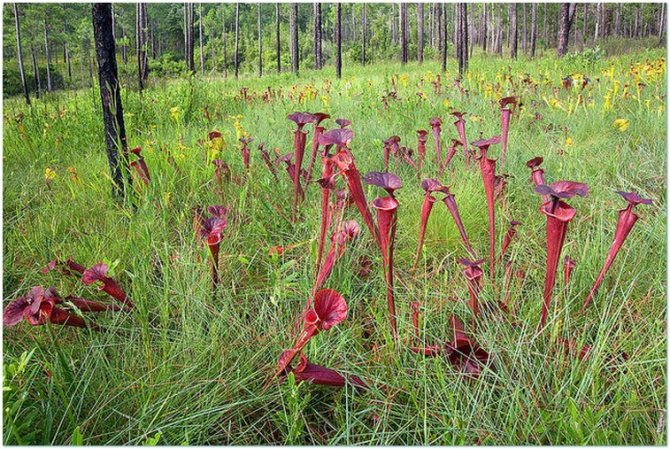

But this is terribly interesting:
- The size of the Nepenthes pitcher trap, one of the largest species of insectivorous plants in the Aristolochian family, allows it to catch rats and small birds.
- One of the enzymes secreted by nepentes is nepenthesium, which decomposes prey proteins into amino acids. These compounds provide the plant with nitrogen, which is often lacking in its habitats in the humid tropics.
- Insect exoskeletons are another potential nitrogen source. They are completely composed of an almost indestructible substance - chitin. However, nepentes can release an enzyme that can dissolve this material as well.
“Many carnivorous plants have spring-loaded valves that are activated by electrical impulses generated by the plant itself.
- The length of the trapping leaves-jugs of sarracenia reaches up to a meter.
Along the coast of North America is growing sarracenia purple
belonging to the family of the same name. Sarracenia jugs are modified leaves growing from the rhizome. Emerald, covered with a dense net of crimson veins, exuding sweet juice, they resemble fabulous flowers. Sometimes the leaves-tubes recline on the surface of the earth, resembling a rising cobra. Their length varies - from 3.8 cm at
Australian cephalotus
up to 60 cm
Sarracenia yellow
... On each trapping leaf there is a kind of "platform", landing on which insects can move only in one direction - to the mouth of the jug. The secreted nectar is so abundant that it flows down the grooves along the entire leaf tube. The upper part of the cavity is covered with sharp hairs directed downward, allowing the victim to easily slide to the bottom, but not letting go back. Sometimes tree frogs are found in the tubes of sarracenia. Birds use them as feeders, taking out live prey. In the last century, gardeners bred many forms of sarracenia, differing in the shape and color of the leaves.
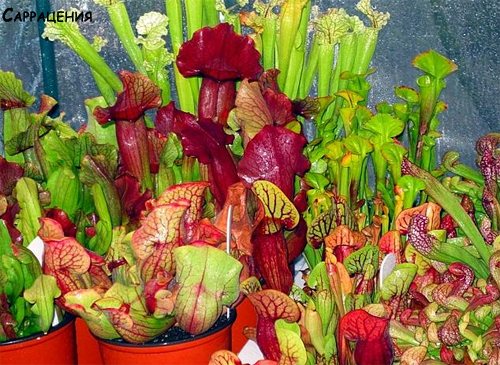

Tropical Asia, Seychelles, Madagascar, and Northern Australia are home to the most powerful of all "predators" - representatives genus Nepentes
... They can grow in the mountains - at an altitude of up to 2000 m, and at the edge of the forest, and even in the surf zone. This vine most often settles on tree trunks, twisting them tens of meters in height and bringing narrow inflorescences to the light.
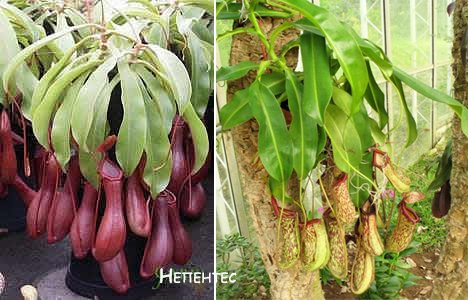

Also, my inquisitive botanical mind has long insisted on purchasing nepentes - it is also an interesting thing. His traps are like jugs. Some are straight with a lid. The other day I saw this in flowers from Alla. There is a dog of 900 rubles. It is necessary to find where they give cheaper and get yourself. I read here on one forum that people feed them chicken. Whinnying. This is how they eat in nature the current of insects, which from drunken eyes will climb into such a jug - they get there into the liquid that the jug produces, akin to gastric juice. Chicken is not eaten. Can not. She does not fit into a jug. In the literature, they write that the Nepenthes eat well and quickly. They have a company of clean jugs.
The nepentes leaf consists of three parts. At the base there is a wide plate that supports photosynthesis. The middle part is endowed with sensitivity, which makes it possible for the plant to wrap around the leaves of the trees. And, finally, the apical - a jug with a lid - for catching insects. The jugs are painted in bright colors: red, milky white and painted with a spotted pattern. Above the mouth there is a fixed lid that protects the contents of the jug from rainwater and serves as a landing site for insects. The prey, attracted by the color, smell and nectar, slides into the jug, as its inner surface is very slippery. Even insects that can move along vertical glass do not keep here. Getting into a liquid containing enzymes and acids, and within 5-8 hours, the extraction is completely digested. Only the chitinous cover remains. However, nepentes can secrete an enzyme that can dissolve even chitin.
On the shores of fresh water bodies, on moist soil, there are erect nepentes with lateral shoots creeping along the ground. The jugs of these plants are hidden in the grass. They can hold up to 1-2 liters of liquid, into which up to several hundred insects, and sometimes rats and small birds, enter. In rooms and conservatories most often cultivated nepentes winged
... Also of interest
nepentes truncated
and
nepentes rafflesi—
with large purple-spotted jugs.
Zhiryanki
- got its name from the Latin pinguis - bold, because of the fleshy, shiny, juicy leaves collected in a large rosette. The upper surface of the leaves is densely covered with glands - on long and short legs. The former secrete sticky, sugary mucus to attract insects, the latter, digestive juice for digesting prey. The insect sticks to the surface of the leaf, after which it slowly curls up and remains in this state for about a day. In summer, a long peduncle with a purple flower, similar to a graceful butterfly, grows from the middle of the rosette. Among indoor plants, the most common
zhiryanka moran
from Mexico and
agnaya fattyanka
.


What where When
In Russian-language literature, as a rule, the term "insectivorous plants" is found, which is not entirely correct, since plants also eat small animals, for example, frogs, snakes, birds. The name "predatory plants" also does not reflect the essence, because these representatives of the flora do not actively hunt. In the English-language literature, you can find the term "carnivorous plants", but it is also far from the essence: for example, pollen cannot be attributed to flesh.
Scientists have been actively studying the insectivorous flora for more than 200 years, but there are still more questions than answers.
Charles Darwin became the first scientist to pay serious attention to this group of plants and to devote a whole volume of scientific works to them.
More than 500 species of predatory plants are now known. They usually grow in humid climates - tropical rain forests, wetlands. Since there are few important substances for them, such as nitrogen, phosphorus, sodium, magnesium, calcium salts, these plants extract the missing elements from animals. But the process of photosynthesis (the creation of organic substances in the light from carbon dioxide and water) is typical for them, as for ordinary plants.
Fossil remains (usually pollen) of "predators" indicate their possible origin in early Cretaceous... Insectivorousness supposedly originated as a protective device against eating. And later it received its development as a form of nutrition.
Home care
Predatory plants are now at their peak of popularity. Fashionable flower. Cool gift. More often to yourself. In order for a domestic green predator to delight and grow without problems, you need to know the characteristic features of its development. Paradox: very moody at home. Despite the unpretentious natural.
But you can try. What do you need?
- Moss or vermiculite soil, cannot be fertilized.
- Do not feed with mealworms, cheese, meat. Only fruit flies or forage cockroaches.
- Use phytolamps instead of direct sunlight.
- In winter they hibernate - they require a temperature slightly above 0C. Many are specially placed in a refrigerator (+ 5C degrees). Watering is reduced.
- It is forbidden to water with tap water. Distilled liquid only.
Plants are predators in the movies
Insectivorous plants, carnivores, have always attracted interest, which is reflected in works of art, films, commercials, computer games, where they were often credited with the ability to reach enormous sizes and other extraordinary properties. One of the first rumors, later debunked, about giant plants eating people on the island of Madagascar, were noted in the descriptions of Dr. Karl Leach, published in the Chronicles of South Australia. However, this myth has gained popularity. So, for example, the plot of the "black comedy" directed by Roger Corman "The Shop of Horrors" is twisted around a flower, which needed the blood of its owner for life, and as his appetite grew, the owner had to diversify the diet of the plant with people.
Catches flies and mosquitoes
Along with sticky paper or insecticides, predatory plants help people to get rid of flies and mosquitoes or at least reduce their number. The Venus flytrap is scientifically called Dionaea (Dionaea muscipula). Her homeland is the savannah of North America. Its size allows you to place vases and pots even in tight spaces. The flower is beautiful, white, with a pleasant aroma. The two doors look welcoming and welcoming, only small teeth along their edge can suggest an ominous prospect for a fly, which wants to sit at least on the edge of this shell. Dionea receives an inaudible signal from one of the three hairs placed in each trap - the valves close. The main phase of movement of the petals is rapid and takes only one tenth of a second, which gives reason to consider the flycatcher more like a fly swatter. However, if the insect is small, it can still escape by making its way through the still existing cracks. In this case, the retention process stops, as does the entire digestive cycle, and after about a day, the entire fly-catching system returns to its original combat position. But that doesn't happen often. Sometimes it happens that two or three insects fall into the trap at the same time.
Household plants are killer. Killer Plants! Don't you dare grow them on the windowsill, otherwise ...
Do you like to plant flowers on the windowsill? But did you know that some of them can pose a terrible danger to you or your loved ones? The seemingly harmless plants can cause allergic reactions or release poison. And "Caprice!" will tell you what kind of plants they are. Read, maybe there is one of your favorites among them.
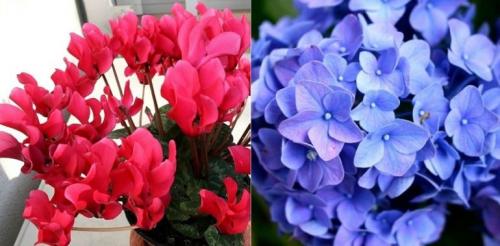

Harmful indoor plants
- Cyclamen Many people believe that this cute and beautiful plant is able to ward off bad dreams and fears. This is a wonderful plant, just do not forget about its poisonous properties. The most poisonous parts are the seeds and roots of the plant, and their juice can irritate and inflame the skin.
So we strongly advise against trying this wonderful recipe, which is quite popular in folk medicine: to bury cyclamen juice from sinusitis. You can burn mucous membranes, get a jump in temperature, sore throat and shortness of breath. In the treatment of sinusitis, this will definitely not help you.

- Dieffenbachia It is difficult to argue with the fact that this plant cleans the air well and improves its chemical composition. Just don't put it in the bedroom, and even more so in the nursery. The juice contained in the stem is very poisonous. If it comes into contact with the skin, it can cause burns, and if swallowed, it is likely to provoke serious digestive and respiratory problems.
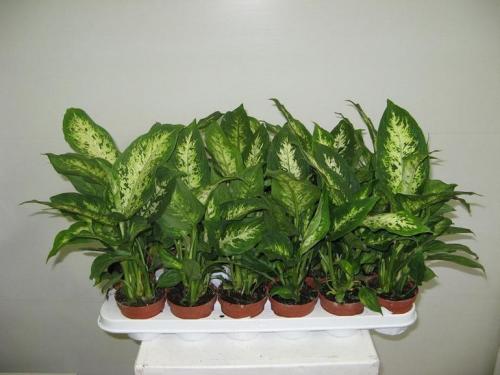

- Cacti These are some of the most insidious houseplants. Even a modest plant contains more than 120 alkaloids in its cell sap, which negatively affect the human nervous system. The hallucinogens contained in cacti can cause paralysis of the nervous system, their effect resembles the effect of LSD.


- Fat woman This plant is in every second house, because it is believed that it attracts wealth and success to the house. It is not for nothing that it is called the money tree. You need to be careful with him, because the plant sap contains arsenic. The number, of course, is not so large, but for domestic animals, great lovers of eating houseplants, this will be quite enough to get poisoned.
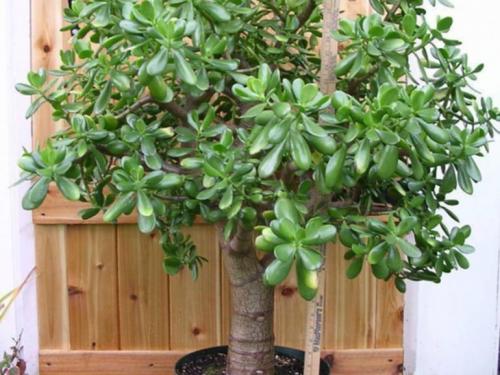

- Hydrangea Hydrangea flowers are filled with unimaginable attraction and even some kind of magic, and all other parts are filled with poison. Touching the plant is quite safe, but if hydrangea juice gets into the body, it can cause increased sweating, stomach pains, itching, nausea, and worsen blood circulation.


- Geranium Yes, exactly, such a useful and beautiful geranium can be dangerous. Geranium is an excellent antiseptic, helps relieve stress, relieves pain in sore throats.However, the smell of geranium can trigger a severe asthma attack and cause an allergic reaction. Geranium is contraindicated in pregnant women, people with low blood sugar and children.
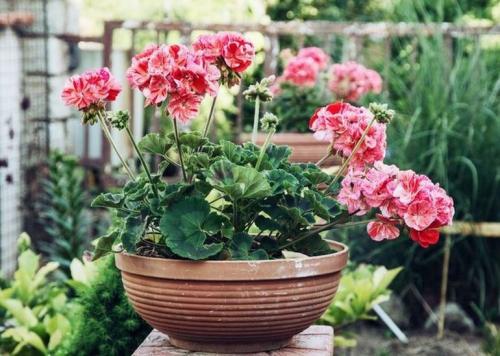

- Poinsettia It is not safe to keep the popular "Christmas star" in the house, because its juice contains alkaloids. Neither flowers nor leaves are dangerous in themselves, whitish sap is dangerous, as in all plants from the genus milkweed. Such a bright plant attracts children and pets, and they happily drag it into their mouths, only this can lead to unforeseen consequences.


These plants are definitely not worth growing at home, no matter how beautiful they are. The beauty is clearly not worth it. Before you buy any exotic plant, be sure to study the information about it to make sure it is safe.
And we offer you a list of favorable indoor plants that are best suited for the home. They will not only become a good decoration, but also cleanse the air of toxins and protect your health. You will definitely find something for yourself!
Be sure to share this useful article with your friends on social networks!
It is interesting:
In 1970, Brazilian naturalist Mariano da Silva discovered in a rainforest on the border with Gajana a carnivorous palm-like tree that fed on broad-nosed monkeys and sloths. The tree fed on what attracted monkeys to itself with a particularly appetizing smell. Inhaling it with dull pleasure, the animals fell into a trance and climbed up the trunk, higher and higher ... where the last supper came for them: the leaves of the crown closed over the unwary animals, so that they turned out to be wrapped in a dense cocoon. So tight that the drugged monkeys did not have time to utter a sound or sob - they died in complete silence.
According to da Silva, for three days the green monster digested the prey, and then, as is customary with the vampire tree, "spat" the gnawed bones on the ground.To Nicaragua George Dunsten encountered such a monster, wandering around the more often in search of rare plants. His dog almost fell victim to the predator. He wandered in search of rare plants in the rainforest, accompanied by a small dog. Distracted, Dunsten suddenly heard his dog's howl and groans. Then there were death rales. The owner rushed to the aid of the faithful dog and found a terrible picture. He saw a dog, entwined with a whole net of roots and a long black vine, strangling the dog. The black liana had already pierced the skin of the animal and was sucking out the blood. With great difficulty, the naturalist cut the living net and freed the dog. Local residents reported later that the dog still got off lightly: usually a black vampire liana drinks all the juices from a living body in the blink of an eye. Devouring an animal lasts no more than five minutes. This tree is called the "snake tree" by the natives.
I remembered a movie, old, English, sort of. There, a flower was brought to a flower shop, and the seller accidentally discovered that he liked blood. He began to feed him with his own blood, the flower grew and he needed more and more blood. He began to feed him with parts of the bodies of people, first with those that he found (corpses), and then he himself began to kill. The flower grew large and ate his girlfriend, the guy wanted to kill the flower, climbed into it with a pistol, but the flower ate it too. And then the flowers bloomed like a sunflower with the faces of those it had devoured.
They are so awful and interesting.
Following my inquisitive mind, I got myself such a Tamagotchi ... A flycatcher has been living in my house for almost a year. He doesn’t eat flies, he’s probably shy, but he regularly entertains his son - he comes to her and touches the traps with his finger: if you touch one trap twice in a row, it slams shut right before our eyes. I just want to tell her - "aaamm!". The child will touch them all and leave with a sense of accomplishment.But she doesn't immediately open them back - sometimes only in the morning, and sometimes (apparently when her hands after eating
not washed ) after a few days.
Insectivores
These predatory plants feed exclusively on arthropods; when meat or mollusks get in, an active process of decay begins. For this purpose, they use a variety of traps, in which a special enzyme is abundantly released, which attracts and digests prey. The largest group of carnivorous plants, some of which grow on the territory of Russia.
Sundew
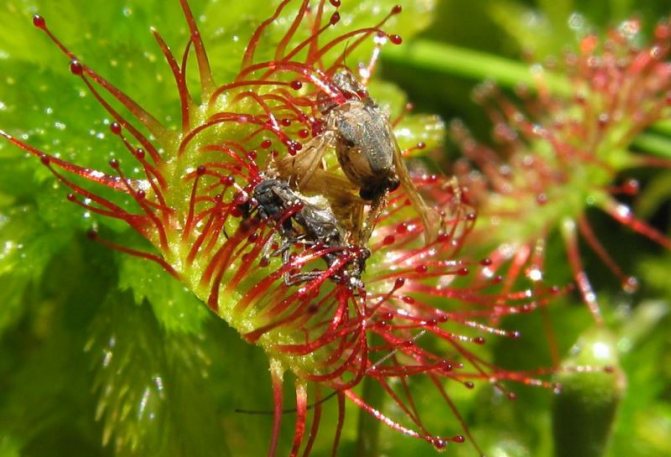

A large genus of carnivorous plants, numbering more than 190 species. They live on almost all continents, preferring marshy and poor soils. A sundew can live in one place for more than 50 years, forming basal or vertical rosettes that are distinguished by an attractive appearance. It is actively cultivated as a home potted flower, which is characterized by whimsical care and cultivation.
The trap of all sundews is represented by moving tentacles, the small hairs of which are abundantly moistened with a sticky enzyme - it is he who attracts small insects (see photo). As soon as the prey lands on the plant, the edges of the leaves begin to curl around it. On average, digestion lasts 1-2 days, after which the trap is reopened.
Zhiryanka
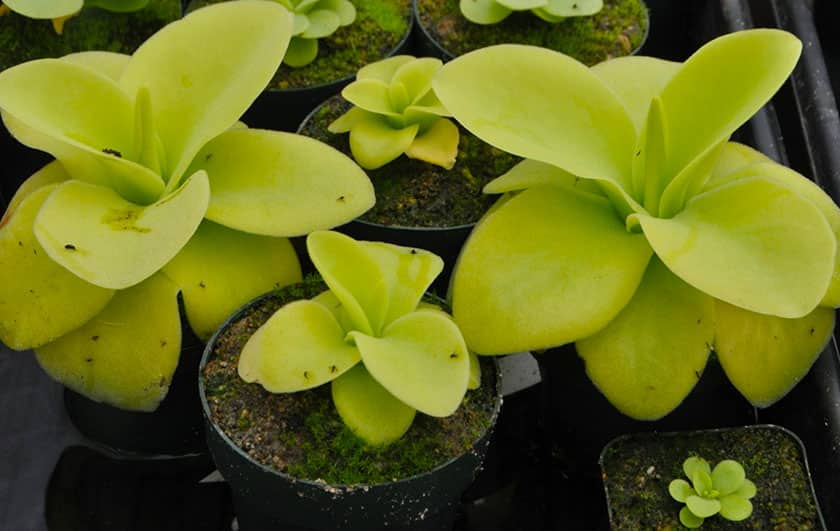

A genus of perennial insectivorous plants found in non-tropical regions of the Northern Hemisphere and Asia. More than 80 species have been described, some of which are on the verge of extinction. It has large leaves of bright green or pink color, abundantly covered with a layer of sticky fat. The plant produces two types of cells that are responsible for the process of producing an enzyme for processing the victim and secreting mucus.
Zhiryanka feeds exclusively on small insects, less often on arachnids. Most species enter the dormant stage in winter, when hunting stops completely. The leaves look extremely decorative, thanks to which the plant is today widely grown as an exotic potted flower.
Sarracenia
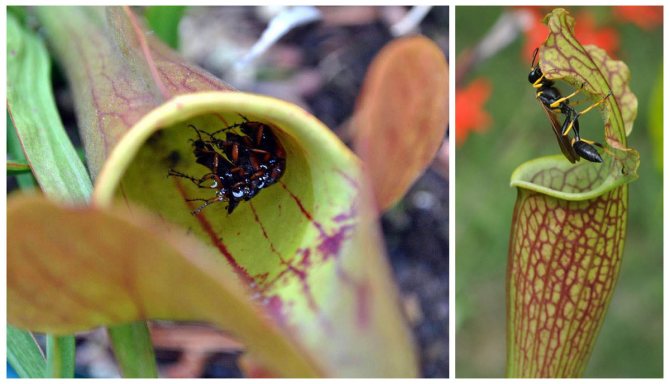

In its wild form, this flower grows in North America and Canada. Prefers moist swampy soils, often grows near water bodies. The plant got its name in honor of the Canadian biologist M. Sarrazen, today more than 500 species are described.
The trap is represented by funnel-shaped leaves in the shape of a red-green water lily. Above there is a small hood that protects the flower from rainwater ingress. The trap produces a secret that exudes a scent that attracts small insects. After getting into the water lily, the victim is digested for several days.
Venus flytrap


The most famous carnivorous plant, actively used as an ornamental home flower. In its natural environment, it is found in the wetlands of the United States, where it is considered an endangered species. The Venus flytrap was described by Charles Darwin, who was surprised at the speed of the trap - it is only 0.1-0.3 seconds. It is she who is most often depicted in pictures in textbooks and manuals in the section on carnivorous plants.
The leaves form two large lobes, colored red or green inside, depending on the variety. Along the edges of the trap, there are small processes that secrete mucus - it is this that attracts small insects, spiders. Inside it there are very sensitive villi that give a signal to collapse the leaf plate when the victim gets inside. One trap is capable of eating up to 3-4 insects, after which it dies.
Cephalotus sac-shaped


A small genus of evergreen insectivorous plants. It is found only in Australia and Albania, where it is under state protection. In the reports of biologists, the beginning of the life of this flower dates back to the Stone Age. As an ornamental potted plant, it is rarely used due to the difficulty in care.
Cephalotus is a small flower, reaching a height of only 5 cm. The trap is represented by a soft, trapping water lily, the jagged edges of which are very decorative. They develop only in summer; during the rest of the year, traditional flat leaf blades are formed.
On top, the water lily is covered with a small lid, which constantly protects the trap from water and dew. It mainly feeds on small flying insects, digestion takes several days.
Flowering and feeding
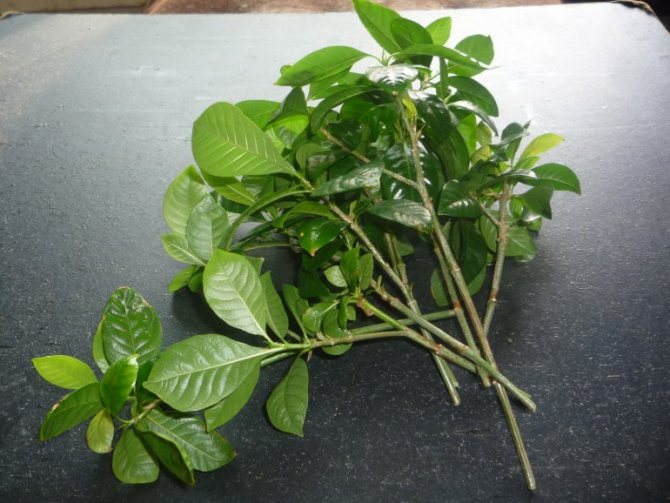

It is necessary to remove the ovaries of flowers, as they tire the flower. But this is not so easy to do, some species have simply gorgeous flowers.
The ideal food for them is what they eat in their natural habitat. Zhiryanka and sundew, if they do not stand in the florarium, can get their own food on their own. Insects with a high calcium content should not be used to feed them. It is best to use fruit flies for this. Flowers rarely grow from seeds. It is advisable to take home an already grown adult plant.
It is interesting:
Central America, in its virgin rainforests, also grow their monsters of the green world, feeding on living things.
One of them looks like a large thick cactus, but it is covered not with thorns, but with real daggers. For the time being, they are motionless. However, an almost incautious traveler will pass between these green knives, as they instantly and without any warning clamp the victim and seal it to the trunk. Here he is the main carnivorous organ. Living daggers pierce a person, blood flows, so necessary for a vampire plant.In the fall of 2000, 63-year-old American Elsa Shader from Orlando Beach, state Florida, sunbathing on a sun lounger in her backyard. Half asleep, she felt something bite into her back.
“I thought it was some kind of insect,” she told The Weekly World News. “But when I turned around, I saw a long green stem crawling over my swimsuit.” Mrs. Shader tried to throw off the plant, but the scion firmly dug into the fabric of the swimsuit. A moment later, a sharp pain pierced her body. She saw her own blood flowing along the stem, as if through a medical tube, pulsing.
To heart-rending screams, the old woman's nephew, who had come to stay, ran out of the house. He managed to rip the vampire plant from his aunt's back. The scion made a disgusting chomping sound and ... quickly reeled off. Botanists from the University of Florida, to whom Elsa consulted, rushed to calm her down. Predatory plants have, in fact, recently settled in some states of the United States. True, while they were fed exclusively by flies and beetles, in extreme cases, frogs.
They live underground, on the surface there is only a small yellow flower. Outwardly, it resembles a harmless snapdragon and serves as a nose for the plant. Sensing a tasty insect nearby, he sends a signal underground. From there, a long, tenacious tentacle instantly jumps out and sucks in the prey. However, until now, no one has yet noted cases of a plant attack on a more or less large animal, and even more so on a person.
However, the old woman stubbornly stands her ground. “I’m lucky that I didn’t sleep at that moment. Otherwise, there was no one to bury, ”she says. Since the day of the attack, the pensioner has not slept normally a single night, she was tortured by insomnia and nightmares. She is afraid to even look into the backyard, despite the fact that the caring nephew tore the evil plant by the roots and burned it. She got Mrs. Shader and all the neighbors, showing them a hole in a swimsuit ...
Experts believe that the old woman was most likely damaged by her mind, and she imagined the whole incident. But pesticide sellers are ready to carry it in their hands, since the demand for their products in Orlando Beach has grown significantly in recent weeks.As it turned out, a predatory snapdragon grows in the town on almost every lawn, and many decided to get rid of it immediately. So to speak, just in case ...
Genus Dionaea
includes only one view -
Dioneae muscipulata
, or
Venus flytrap
... The flycatcher develops a rosette of leaves gathered around a long peduncle with several large white flowers. The leaf blades are divided into two rounded valves, located at an angle to each other, with long strong teeth at the edges. When the halves of the leaf are closed, a real trap is formed. Three sensitive hairs on the flaps set the trap in motion. A powerful electrical impulse that makes it slam shut comes from the base of the plant only if the insect touches two of them. This happens within 1/5 of a second. The trap is kept in this state for at least 40 hours. And if it "misses" or something inedible gets in, the leaf will open again in half an hour.


Advice: The plant forms underground pseudobulbs, so it can disappear in winter and start growing again in spring.
Aldrovanda - floating trap
Bubble aldrovanda lives in water. She is a record holder in two nominations. Firstly, this is a carnivorous creature (it is difficult to call it a flower, rather some kind of algae) grows very quickly, almost by a centimeter every day. This does not mean that aldrovanda will soon flood all tropical waters. How quickly it lengthens, just as rapidly and shortens. This plant has no root, it grows at one end, and dies at the other.
The second unique feature of aldrovanda is considered by biologists to be its traps. They are very small, up to three millimeters, but they are enough to catch small aquatic vertebrates, and do it swiftly. The trap consists of two halves covered with hairs. The response time is measured in tens of milliseconds, which is a kind of speed record. Such a fast movement of a living organism has no analogues.


Biblis
Biblis (Byblis) - externally it is a small plant, painted with the colors of the rainbow. His homeland is in Australia.
The variegated plant is covered with a special, sticky mucus secreted by the glandular villi that completely cover the leaves. The adhesive becomes a trap for insects caught on the leaves or tentacles of the flower.
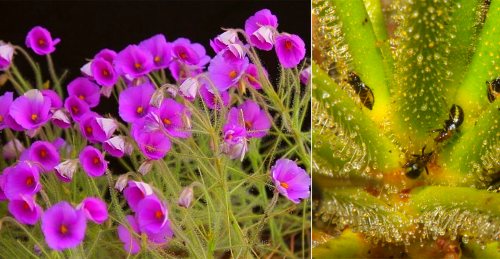

Biblis
The shape of the leaves is round, slightly elongated with a transition to a cone at the edge. The flowers are zygomorphic with 5 curved stamens.



